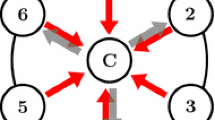Abstract.
Most studies of movement coordination deal with temporal patterns of synchronization between components, often without regard to the actual amplitudes the components make. When such a system is required to produce a composite action that is spatially constrained, coordination persists, but its stability is modulated by spatial requirements effected, we hypothesize, through the component amplitudes. As shown experimentally in part I, when a redundant three-joint system (wrist, elbow, and shoulder) is required to trace a specified arc in space, the joint angles may be frequency- and phased-locked even as the curvature of the trajectory is manipulated. Transitions between joint coordination patterns occur at a critical curvature, accompanied by a significant reduction in wrist amplitude. Such amplitude reduction is viewed as destabilizing the existing coordinative pattern under current task constraints, thereby forcing the joints into a more stable phase relationship. This paper presents a theoretical analysis of these multijoint patterns and proposes an amplitude mechanism for the transition process. Our model uses three linearly coupled, non-linear oscillators for the joint angles and reproduces both the observed interjoint coordination and component amplitude effects as well as the resulting trajectories of the end effector.
Similar content being viewed by others
Author information
Authors and Affiliations
Additional information
Received: 2 February 1996/Accepted in revised form: 13 December 1996
Rights and permissions
About this article
Cite this article
de Guzman, G., Kelso, J. & Buchanan, J. Self-organization of trajectory formation . Biol Cybern 76, 275–284 (1997). https://doi.org/10.1007/s004220050339
Issue Date:
DOI: https://doi.org/10.1007/s004220050339




